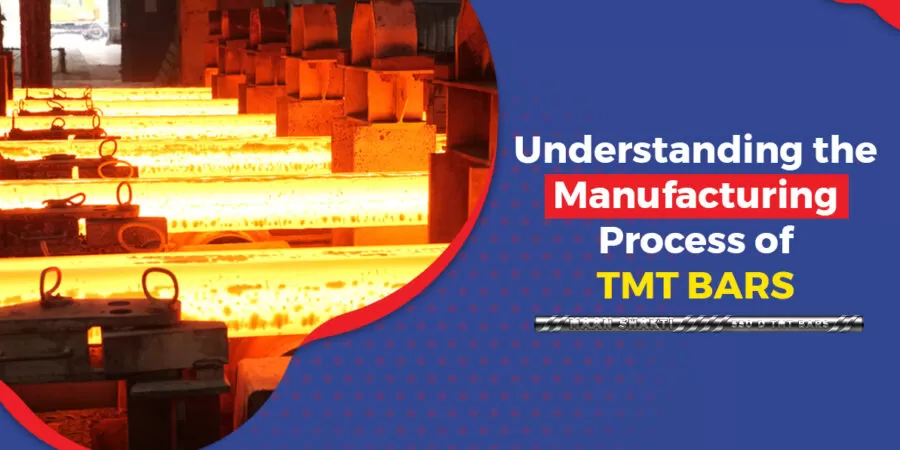As the proverb goes, knowledge is power. And TMT bars reflect the same. The knowledge of its manufacturing process helps you in a way that is of paramount importance.
TMT bars have become the go-to solution or the preferred construction material for engineers to build robust and reliant structures. And the market is flooded with several brands of steel TMT bars, all of which are not the same quality. But choosing the best quality TMT is essential so that your structure stands the test of time, and here is where the knowledge of the TMT bar manufacturing process comes in. Knowing the process, you should be able to easily differentiate between a top-quality TMT and a below-grade bar, thus helping you choose the best from the available options.
As a leading Manufacturer of TMT Bars, we have come up with the general manufacturing process here. Go through the post thoroughly and learn how these steel bars get manufactured so that you can choose the aptest one for your next construction.
TMT Bar Manufacturing in Three Steps
The entire manufacturing process of TMT bars can be divided into three major steps –
- Processing of iron ore to make steel
- Conversion of iron to steel
- Thermo Mechanical Treatment
Processing of Iron Ore
First, the raw materials required to build the TMT bars, viz. Iron ore, coal/coke, and the fluxes (limestone and dolomite) are sourced from their respective locations and are stacked, reclaimed, and blended in the required proportion.
The iron ore is then beneficiated to increase the iron content in it. Next comes building pellets. These are made from iron ore fines which are agglomerated to form pellets and sinter to increase productivity. The coal is turned into coke for later use.
Iron is produced in a blast furnace. The manufacturer of TMT bars charges coke, ore, and sinter from the top of the blast furnace together with limestone. There are nozzles at the base of the furnace through which a hot air blast is injected. The iron ore is thus reduced, and the iron in the ore and the sinter is melted, and a pool of molten metal is collected in the bottom or hearth of the furnace. The limestone, which was fed as a flux, blends with the impurities forming a liquid ‘slag’ which floats on the top of the metal, being lighter than it. The top TMT Bar Manufacturers in Kolkata follow this process to process raw iron ore.
Conversion of molten iron to steel
This process aims to produce billets. For that, the molten iron is collected and subjected to pre-treatment and is converted to steel in a Basic Oxygen Furnace. Now, the molten iron from the blast furnace is put into the BOF and oxygen is blown through it. The oxygen combines with carbon from the iron and converts it into Carbon di Oxide.
The steel is further subjected to Ladle heating, through which the chemistry of the steel is refined. This process is carried out in Ladle Heating Furnace (LHF) and RH Degasifier.
Next follows the continuous casting process. Billets are formed by pouring the molten metal is poured into a casting machine.
Thermo Mechanical Treatment
The bar is formed from the billet. After a hot rolled bar leaves the final mill stand, it is instantaneously subjected to quenching. Quenching is a procedure where the rebars are rapidly cooled to get them specific material properties. A special water spray system is used in the quenching box. The aim of this process by the Best TMT Bar Manufacturers is to make the surface hard while keeping the core soft and hot.
After the bar leaves the quenching box, the core continues to supply heat to the surface since it is at a higher temperature than the surface. The outer Martensitic layer is tempered by this process into a structure called tempered martensite. The core remains austenitic (a cubical crystalline structure) in this stage as well.
After self-tempering, the bars produced by the Leading Manufacturer of TMT Bars are cooled in the atmosphere at room temperature on special cooling beds where the austenitic core transforms into a ductile ferrite-pearlite structure. The final structure is one with a strong outer layer and a ductile core.
Conclusion
This is the manufacturing process of TMT bars. The unique manufacturing process adds to the durability and the unique features because of which these bars are so popular. Material of Construction definitely plays a role in making such high-quality bars, but the manufacturing process creates the difference between low-quality and superior-quality TMT bars.
Now as you know the procedure followed by the manufacturer of TMT bars, you can easily choose the best bars for your project. Whichever brand you choose, just enquire about their manufacturing procedure, compare it with the process explained above, and if you find any discrepancy, go for a different brand.


Leave a Reply